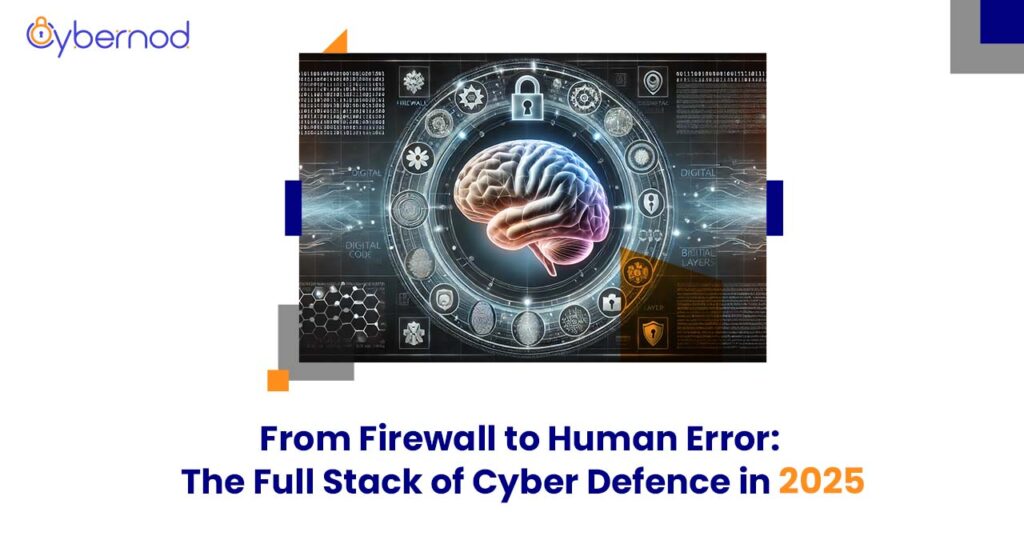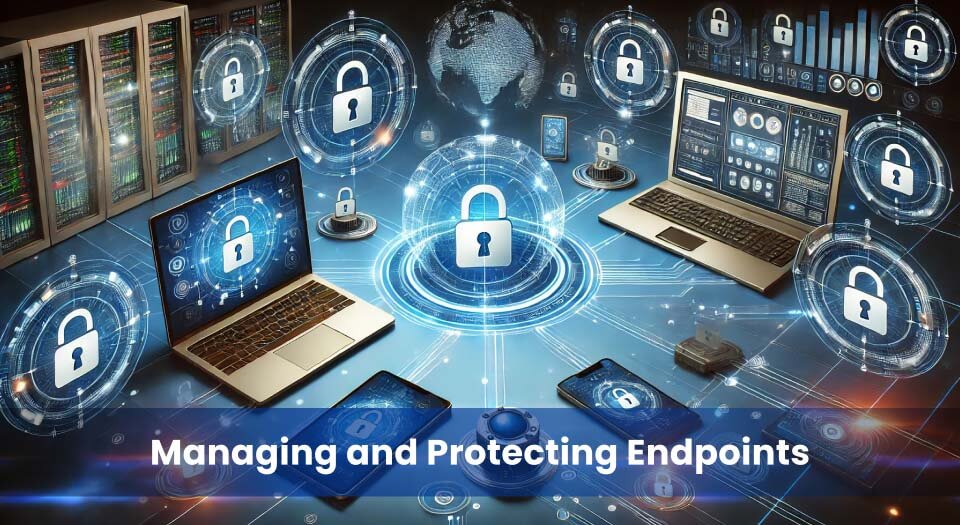
Understanding the Full Stack of Cyber Defence
Choosing the best cybersecurity solution for small business has become a critical priority as threats continue to evolve in complexity and frequency. In 2025, cyber defence is no longer limited to firewalls and antivirus software. A truly secure environment is built on a full-stack approach—one that integrates technical safeguards, robust identity controls, proactive risk assessment, and user awareness programs.
This article explores the layers that comprise a modern cybersecurity stack, from traditional perimeter defences to the often-overlooked human factor. With growing regulatory expectations and rising incidents of data breaches targeting small businesses, understanding the complete landscape of cybersecurity is not optional—it is essential.
Whether you’re performing a cybersecurity risk assessment, conducting a security gap analysis, or evaluating cybersecurity services for small business, knowing how each layer contributes to protection helps organisations make informed decisions. Throughout this guide, we will provide practical insights, visual aids, and trusted resources to help small and medium-sized businesses (SMBs) choose the best cybersecurity solution tailored to their needs.
Layer One: Perimeter Defence Still Matters (Firewalls & Network Security)
While much of the cybersecurity conversation in 2025 focuses on cloud-native threats and identity management, perimeter defence remains a foundational layer of protection. Despite the evolving nature of cyber threats, firewalls, intrusion prevention systems (IPS), and secure network architecture continue to serve as the first line of defence—especially for small businesses.
A properly configured firewall controls incoming and outgoing traffic based on an organisation’s security policies. When paired with modern network segmentation and intrusion detection systems (IDS), it reduces the risk of lateral movement by attackers within the network. For many small businesses, investing in a unified threat management (UTM) solution offers a cost-effective way to combine firewall, antivirus, VPN, and content filtering functionalities into one appliance.
Cloud-based perimeter defences have also gained traction, particularly among businesses with hybrid or remote teams. Tools such as cloud access security brokers (CASBs) provide visibility and control over data as it moves between users and cloud services, making them valuable in securing SaaS environments.
Understanding how to choose the best cybersecurity solution for small business begins at the edge of the network. A strong perimeter sets the tone for the entire security posture and enables better threat detection and response across all other layers.
Firewalls, IDS/IPS, Network Segmentation
Antivirus, EDR, Patch Management
IAM, MFA, SSO Integration
Encryption, Backup, DLP Policies
Training, Awareness, Social Engineering Defence
Layer Two: Endpoint Security and Device Management

As remote work, BYOD policies, and hybrid infrastructures expand in 2025, securing endpoints has become a critical aspect of every cybersecurity framework. While firewalls protect the perimeter, endpoints such as laptops, mobile devices, and IoT components often serve as the initial access point for attackers. Therefore, endpoint security is essential for businesses that aim to choose the best cybersecurity solution for small business.
Modern endpoint protection platforms (EPP) combine antivirus, anti-malware, and behaviour monitoring. More advanced solutions—known as endpoint detection and response (EDR)—provide real-time analytics, threat hunting, and automated incident response. For small businesses, selecting a managed EDR solution can offer enterprise-grade protection without internal resource strain.
Mobile device management (MDM) tools are also increasingly vital for organisations supporting remote teams. These tools enforce security policies, encryption, remote wipe, and access controls on mobile and portable devices. In addition, regular patch management across all endpoints reduces the risk of exploitation through known vulnerabilities.
Effective endpoint security ensures that data integrity is maintained even outside the network. A device-centric approach complements other cybersecurity layers and reduces the overall risk exposure, supporting efforts such as cybersecurity assessment and gap analysis cyber security initiatives.
Securing endpoints is critical, especially in environments that interact with emerging technologies like blockchain and smart contracts. To understand the specific vulnerabilities and preventative measures for these blockchain-based agreements, refer to our article: “Smart Contracts and Security: Preventing Exploits in the Blockchain Era“.
Layer Three: Identity and Access Management (IAM)

Identity and Access Management (IAM) is a pivotal layer in any modern cybersecurity framework. As businesses digitise more of their operations and shift to cloud environments, controlling who has access to which systems—and under what conditions—has become central to risk mitigation. For small businesses seeking to choose the best cybersecurity solution, IAM plays a non-negotiable role.
IAM systems ensure that only authorised individuals can access sensitive resources, whether on-premises or in the cloud. Features like multi-factor authentication (MFA), single sign-on (SSO), and role-based access control (RBAC) reduce the likelihood of unauthorised access and credential theft. Small businesses can leverage affordable cloud-based IAM platforms such as Microsoft Entra, Google Workspace IAM, or Okta to implement scalable, secure access controls without large overhead.
Moreover, IAM platforms integrate with endpoint protection and data loss prevention systems, creating a seamless security posture. Monitoring user access logs also assists in performing regular cybersecurity risk assessment and identifying suspicious behaviour patterns early.
IAM Access Control Flow
e.g. login to business system or cloud service
Multi-factor authentication ensures user legitimacy
Access granted based on user’s defined role
User behaviour tracked for anomalies or violations
Layer Four: Data Protection and Backup Strategies

As data becomes the most valuable asset for many organisations, protecting it across all stages—at rest, in transit, and during processing—is essential. A comprehensive data protection strategy not only guards sensitive information but also supports compliance with privacy regulations such as the GDPR and Australia’s Privacy Act.
Encryption remains a cornerstone of data protection. Small businesses should implement encryption both on local storage and during data transmission to prevent unauthorised access. In addition, data classification frameworks allow businesses to label and prioritise protection for sensitive files such as financial records, intellectual property, and customer information.
Equally important is implementing regular and automated backup solutions. Backups must be encrypted, stored in secure offsite or cloud locations, and periodically tested for integrity and recovery efficiency. Using a 3-2-1 backup strategy—three copies of data, two stored locally, and one offsite—ensures availability during incidents such as ransomware attacks or hardware failures.
For businesses working to choose the best cybersecurity solution for small business, robust data protection and backup planning are non-negotiable. These measures form the foundation of any reliable cybersecurity risk assessment and are often required to comply with cybersecurity regulations for small businesses.
Layer Five: Human Factor – Awareness, Mistakes & Social Engineering

Despite advances in automation and artificial intelligence, human error remains one of the most persistent vulnerabilities in cybersecurity. In fact, a significant proportion of successful data breaches stem not from technical flaws, but from social engineering tactics, poor password practices, and lack of user awareness.
Small businesses—often operating without dedicated cybersecurity teams—are particularly exposed to human risks. Common issues include falling victim to phishing emails, reusing weak passwords across systems, or using unauthorised applications that bypass company policies. These oversights can compromise even the most robust technical defences.
Investing in cybersecurity awareness training is one of the most cost-effective ways to mitigate these risks. Platforms such as Hoxhunt and KnowBe4 offer simulated phishing campaigns, role-specific training, and behavioural analytics that help reinforce security culture across teams. Regular policy updates, incident response simulations, and staff engagement programs further enhance resilience.
Incorporating human-centric security controls into a broader cybersecurity risk assessment allows organisations to identify weak points that purely technical audits may miss. For businesses aiming to choose the best cybersecurity solution for small business, addressing the human element is as critical as deploying firewalls and endpoint protection.
| Common Human Error | Impact | Prevention Method |
|---|---|---|
| Clicking on phishing emails | Credential theft, malware infection | Simulated phishing training and real-time awareness |
| Using weak or repeated passwords | Account compromise, lateral movement | MFA enforcement and password manager adoption |
| Accessing unapproved applications | Shadow IT, data leakage | Application whitelisting and usage policies |
| Failing to report suspicious activity | Delayed breach response | Clear reporting procedures and incident drills |
Full Stack in Action: Combining All Layers for Effective Defence
An effective cybersecurity strategy is not built on a single solution but rather on the integration of multiple defensive layers working in harmony. Each layer—whether it’s firewall protection, endpoint security, identity management, data protection, or user awareness—plays a distinct role. When combined, they form a cohesive defence-in-depth model capable of withstanding diverse attack vectors.
For example, even if a phishing attempt bypasses a spam filter and tricks a user into revealing their credentials, a well-configured IAM system with multi-factor authentication may prevent access. If malware reaches an endpoint, EDR tools can detect and contain it before it spreads. In the worst-case scenario of a successful breach, encrypted backups ensure that data can be recovered without succumbing to ransom demands.
This synergy among layers helps small businesses build resilience without relying solely on any one tool or vendor. It also supports regular cybersecurity assessment and a structured approach to identifying gaps through security gap analysis.
To choose the best cybersecurity solution for small business, organisations must think holistically—understanding that true protection lies in how well each security layer complements the others.
Selecting the Right Stack: What Small Businesses Should Prioritise
For small businesses, selecting the right cybersecurity stack involves more than purchasing off-the-shelf tools. It requires a clear understanding of risk exposure, resource availability, regulatory obligations, and organisational needs. Without strategic planning, even well-intentioned investments can lead to overlapping controls or critical blind spots.
A practical first step is to conduct a cybersecurity risk assessment. This helps identify which assets are most vulnerable and which threats are most likely to target them. From there, businesses can apply a security gap analysis to pinpoint weaknesses across their current defence layers.
Not all small businesses need the same stack. For example, a law firm handling sensitive client data may prioritise encryption and IAM, while a retail business might focus on endpoint protection and fraud detection.
Cost-conscious organisations can begin with free cybersecurity resources for small businesses—such as policy templates, phishing simulations, and vulnerability scanning tools—available from government portals and cybersecurity vendors.
Ultimately, to choose the best cybersecurity solution for small business, decision-makers should follow a layered, risk-based approach that aligns protection efforts with their operational goals and compliance requirements.
Decision Tree: Choosing the Right Cybersecurity Stack
If yes: Prioritise encryption and IAM (Identity & Access Management).
If yes: Deploy endpoint protection and mobile device management (MDM).
If yes: Implement security awareness training and enforce MFA.
If no: Set up automated encrypted backups using the 3-2-1 strategy.
Securing the Future Through a Unified Cybersecurity Stack
Cybersecurity in 2025 is no longer about isolated tools—it’s about synergy. From perimeter defences to human awareness, every layer in the cybersecurity stack has a role to play in safeguarding business continuity. For small and medium-sized enterprises, understanding these layers is the first step. The next is strategic implementation.
By aligning defence priorities with business operations, conducting regular cybersecurity assessments, and addressing both technical and human vulnerabilities, organisations can significantly reduce their exposure to threats. Choosing the best cybersecurity solution for small business requires not only awareness but also trusted expertise.
At Cybernod, we help small and growing businesses take control of their security posture—efficiently, affordably, and intelligently.
Get your free cybersecurity gap analysis and discover where your business stands.
🔍 Identify exposed vulnerabilities, strengthen your weakest layers, and ensure compliance.
👉 Start Your Free Cybersecurity Assessment Now
Let Cybernod help you build a cybersecurity stack that works—from firewall to human error and beyond
Categorized in: